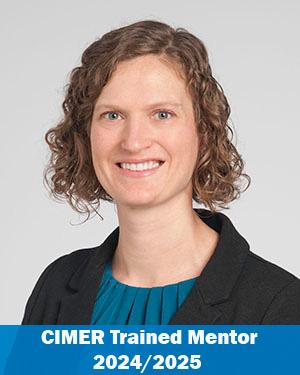Research News
06/12/2025
Skin cancer predictive models help researchers forecast patient outcomes
Oncology predictive models can aid clinicians in diagnosis and prognosis.

Despite being the most common cancer diagnosed in the U.S., there is no common treatment for skin cancer. The patient, type and stage of cancer all influence potential outcomes, such as cancer recurrence and mortality, to quickly select the right treatment options for each patient.
Emily Zabor, DrPh, Biostatistician, has been developing predictive models for over 15 years to help clinicians and patients make the best choices for their care. She says these models are a great example of how computational research has a direct impact on patient care.
What are oncology predictive models?
There are two different types of predictive models that cancer researchers typically work with: diagnostic models (identifying a cancer) and prognostic models (predicting the course of a cancer).
Dr. Zabor usually focuses on prognostic models to help researchers determine how cancer will progress and how different treatments will affect their patients.
She recently collaborated with Arun D. Singh, MD, Director of Ophthalmic Oncology, Cleveland Clinic Cole Eye Institute, to create a predictive model for iris lesions becoming melanoma. Dr. Singh realized there was a need for a predictive model after seeing several patients who sought a second opinion after being advised to have a surgical excision.
“Dr. Singh reached out to our team because eye preservation is critical to patient well-being,” says Dr. Zabor. “By creating a predictive model, we can help clinicians more accurately determine when surgical excision is necessary.”
How are oncology predictive models developed?
The three main stages for creating a predictive model are development, validation and deployment.
The development of a model usually begins when a clinician notices a need for a computational tool to assist with patient analysis. The clinician works with a research team to identify the variables that have the biggest impact on patient outcomes, like age, sex and stage of cancer. The researchers use this data to create a statistical analysis.
Dr. Zabor and Dr. Singh’s predictive model, published in the British Journal of Ophthalmology, uses a combination of iris pigmentation, tumor size and tumor location to determine the likelihood of a benign lesion becoming melanoma. Once the model was developed, the researchers tested the accuracy of the model by running it on an existing data set. This allowed them to compare the predicted outcomes with actual patient outcomes.
“When we develop these models, we think of the clinicians and patients who need these tools to help get a prediction of something that can be really scary and life changing,” Dr. Zabor says. “I feel a great sense of responsibility to ensure my methods are accurate and available to the people who need it most.”
Many of the models created by Cleveland Clinic are made available online so that they can be used by other clinicians and researchers. The tool that Dr. Zabor and Dr. Singh developed can be found here.
Featured Experts
News Category
Related News
Research areas
Want To Support Ground-Breaking Research at Cleveland Clinic?
Discover how you can help Cleveland Clinic save lives and continue to lead the transformation of healthcare.
Give to Cleveland Clinic